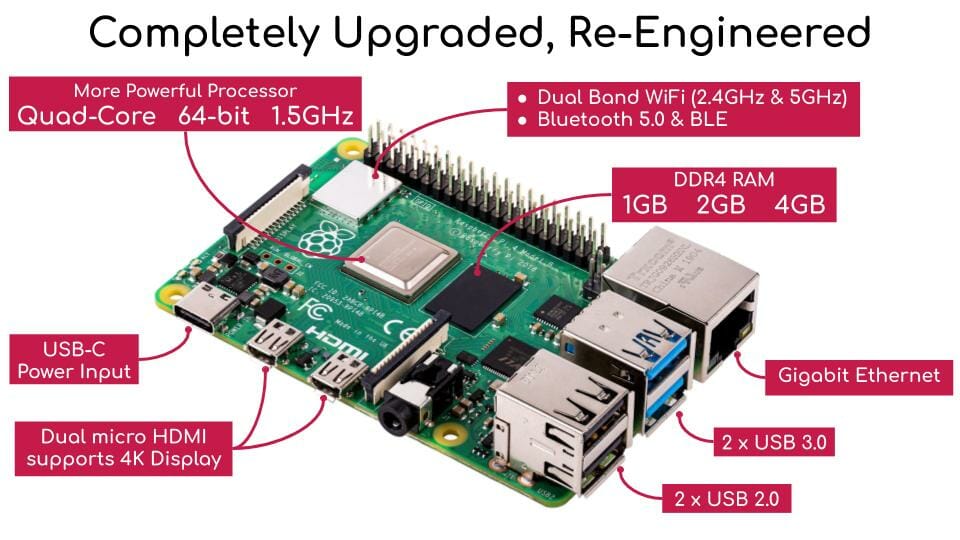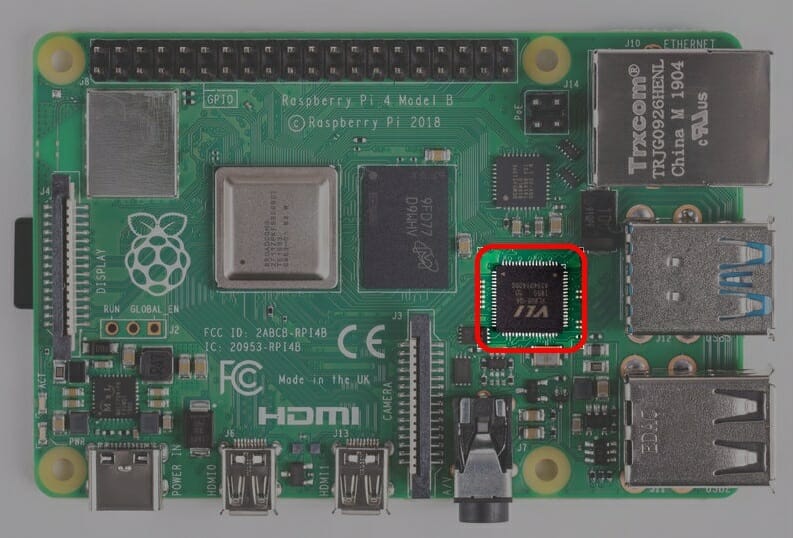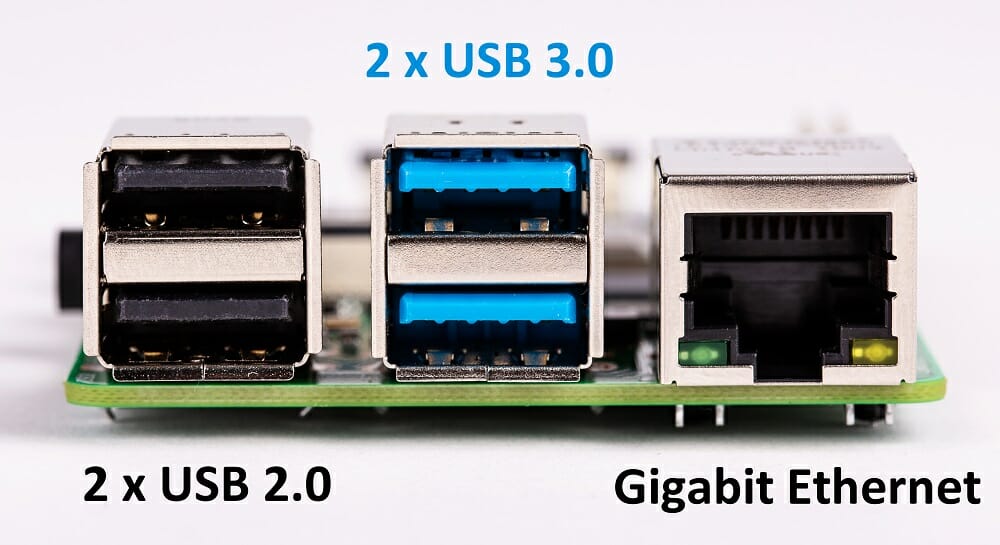Your shopping cart is empty!

5 Major Upgrades on Raspberry Pi 4 Model B
It caught everyone by surprise when Raspberry Pi Foundation launched Raspberry Pi 4 Model B on 24th June 2019 because from the interview with Eben Upton, by Tom’s Hardware, it should not come in 2019 :)
Anyway, I believe most of us are happy and excited to see Raspberry Pi 4 Model B being launched earlier than expected. Let’s take a look at what are the improvements and I will elaborate 5 major upgrades that you might love or maybe…. Hate?? Let’s start!
The Overview of Raspberry Pi 4 Model B
Black color text indicates no changes from Raspberry Pi 3 Model B+
Picture tells a thousand words, while maintaining the PCB size and most of the components layout, Raspberry Pi design team had again amazed us by squeezing many upgrades that we anticipate for so long.
1. Upgrade of SDRAM from DDR2 to DDR4, up to 4GB
Many would agree with me, we will choose the latest SDRAM technology and biggest RAM size when we want to get a laptop or smartphone. It applied to getting the single board computer too, but Raspberry Pi has been using DDR2, century old technology, and maximum capacity of 1GB since Raspberry Pi 2 up until Raspberry Pi 3B+. Many projects have seen constraints due to the RAM speed and size. Well, Raspberry Pi 4 Model B fulfill both these wishes. It offers not a jump to DDR3, but double upgrades to DDR4. Raspberry Pi 4 Model B comes with DDR4 RAM which offers lower operating voltage at 1.2V vs 1.8V on DDR2, and faster data access of 2133 to 3122 Mt/s (Megatransfer per second). With DDR4 SDRAM, Raspberry Pi 4 B will run faster even if the RAM remains at 1GB :) But, it does not stop there, Raspberry Pi 4B comes with 3 RAM size variants. The standard basic board begins at 1GB, if you are using it as a media player, edge computing or browsing the Internet with multiple tab, there are 2GB and 4GB choice for you :) So now, you don’t have excuses that Raspberry Pi does not have high speed or enough RAM!
RAM Upgrades on Raspberry Pi 4 Model B
2. Boosting Processor Performance with Cortex-A72 instead of Cortex-A53
It will not be Raspberry Pi 4 without the upgrade of processor right? Raspberry Pi 4 B has upgraded the processor from BCM2837, Cortex-A53 on Raspberry Pi 3B+ to BCM2711, Cortex-A72 that focus on performance. According to Processor Digest, A72 is bigger core that comes with more L1 and L2 cache. While A72 may consume more power, the 28nm technology on new BCM2711 actually offers lower power compared to 40nm SoC on Raspberry Pi 3 B+. Overall, you will see better performance on Raspberry Pi 4 B with the quad-core A72 processor running at 1.5GHz. Of course with higher performance, it will dissipate more heat, so if you feel your Raspberry Pi 4 Model B is warmer, it is normal, get an enclosure with a cooling fan for it. Keep it cool!
The new Quad-core Cortex-A72 SoC
3. True Gigabit Ethernet Port
We are kind of disappointed when the Ethernet speed is not true Gigabit on Raspberry Pi 3B+ as it is limited by USB + Ethernet hub that interfaces via USB2.0 to the processor. I am pretty sure you will be happy now, Raspberry Pi 4 B comes with true Gigabit Ethernet port! This latest Raspberry Pi computer uses BCM54213PE Single Port RGMII Gigabit Ethernet Transceiver to perform all physical-layer functions for 1000BASE-T Ethernet. This is a true gigabit Ethernet transceiver as opposed to the Microchip’s LAN7515, USB, and Ethernet hub. Theoretically, LAN7515 is able to handle Gigabit Ethernet, but it is interfaced to processor via USB2.0 on Raspberry Pi 3B+, therefore the actual Ethernet speed is limited to 300Mbit/s. Actual test results show Ethernet speed over 900MBit/s Anyway, with true Gigabit Ethernet port on Raspberry Pi 4 B, making it as a media server to stream media files or a VPN server will be smoother, a big improvement for many Internet speed intensive applications! We are looking forward to seeing the advance applications you can do with this upgrade.
The BCM54213PE Ethernet Transceiver IC, PoE Header Pins and True Gigabit Ethernet Port
There is a change that you might not like, though. The Ethernet port is being swapped with 2 USB ports. I believe the reason behind this swap is to place the Ethernet close to PoE (Power over Ethernet) pins and further shorten the PoE power tracks on PCB. This improves the efficiency of PoE. With that we are pretty sure Raspberry Pi 4 Model B will still be fully compatible with the official Raspberry Pi PoE HAT.
On the other hand, with this swap, most of the enclosure for Raspberry Pi 3 B or B+ will NOT be compatible with Raspberry Pi 4 B :( That’s the give-and-take, I guess.
4. USB 3.0 Ports
USB is another great upgrade for connectivity on Raspberry Pi 4 Model B. There are still four (4) Universal Serial Bus (USB) ports, but two (2) of them are upgraded to USB 3.0, while the other two remain USB 2.0. Pi 4B comes with VIA’s VL805 4 ports USB 3.0 Host (only) controller that supports a PCI Express interface and enabled the SoC to interface with USB Super-Speed - 5 Gbit/s (625MB/s), High-Speed - 480 Mbit/s (60MB/s), Full-Speed - 12 Mbit/s (1.5MB/s), and Low-Speed - 1.5 Mbit/s devices.

VIA’s VL805-06 USB 3.0 Host Controller
Raspberry Pi 4 B only implements two USB 3.0 ports though, and that is sufficient for many projects that require high speed USB connection like media server, data logging, USB to SATA hub, or high speed & resolution USB camera. Best of all, USB3.0 is backward compatible, you can still connect all your USB 2.0 devices (mouse, keyboard, webcam, flash drive, etc) to these blue color ports :)

Looking from the side, 2 x USB 2.0, 2 x USB 3.0 and Gigabit Ethernet, from left.
5. 4K Video with 2 x Micro HDMI that support Dual Display
Computer is always good for multimedia projects, and we know there are many Raspberry Pis being used as media box, computer laptop, kiosk or advertisement panel. You will love this upgrade, Raspberry Pi 4 Model B comes with VideoCore VI that supports:
- H.265 (4Kp60 decode) - 4K resolution at 60 frames per second
- H.264 (1080p60 decode)
- H.264 (1080p30 encode)
- OpenGL ES, 3.0 graphics
Well, there are plenty of technical specification there :) In short, Raspberry Pi 4 Model B is capable of delivering 4Kp60 multimedia experience, Awesome!
As the GPU on BCM2711 is capable of supporting dual/twin display, Raspberry Pi 4 B comes with two HDMI ports. And to accommodate two HDMI ports, micro HDMI port is chosen :) It looks like USB mini B port at first glance, but that is micro HDMI. Now, you can get dual monitor/display with Raspberry Pi 4 model B, making advertisement panel or kiosk should be fairly easy and interesting. The latest Raspbian should come ready to support this feature, yet we have not tested it. Practically, 4B will not be able to output dual 4Kp60 display due to other hardware limitations, but dual 1080p60 is possible, Raspberry Pi team is looking at making dual 4Kp30 display via these micro HDMI ports.
Two micro HDMI Ports
You might love these upgrades too:
a. USB Type C for true 15W input power
Yup, there is USB type C on Raspberry Pi 4 Model B, but it is meant for power input. Conventionally, all Raspberry Pi boards use USB micro B jack as a power input port. But as the power requirement of Raspberry Pi increases in the new model, USB micro B is not suitable to deliver high current power to the board. So is kind of natural for this computer to upgrade the power port to USB type C. The USB type C port can only support 5V and not other power mode. Do get yourself the official power adapter for Raspberry Pi 4 from here, 15W, 5V/3A, 1.5-meter cable length.
The new USB-C as Power Input Port
B. Bluetooth 5.0 upgrade from 4.2 on 3B+:
Although it is hidden under a metal shield, it is actually packed with various wireless connectivity that include WiFi IEEE 802.11 b/g/n/ac (dual band, 24GHz & 5GHz) and Bluetooth. And on Raspberry Pi 4 Model B, the Bluetooth 4.2 has been upgraded to 5.0, and preserves the BLE (Bluetooth Low Energy).
Thanks to to Amar Info Tech that written very detailed article on Bluetooth 5.0 vs 4.2,
“Bluetooth 5.0 is the continuation of Low Energy LE. Its speed is 48MBps (double than the last version). It can be connected up to the distance of 300 meters or 985 feet (4 times last version). The ISM band ranges from 2.4-2.485 GHz. One little disappointing thing for users is that it doesn’t have any backward compatibility with its old or previous versions. It requires new hardware which should be latest and advanced so that those devices meet the requirements of Bluetooth v5.0 to run it smoothly.”, by Amar Info Tech
The new Wireless connectivity on Raspberry Pi 4 Model B
Now, the Bluetooth on Raspberry Pi can offer faster speed and longer wireless connectivity :)
Summary:
I am pretty excited when I first see the spec of this new credit-card-sized computer. I am amazed by the upgrades Raspberry Pi engineering team has been able to squeeze into this board and still maintain backward compatibility. Not all, but most :) Looking forward to seeing more interesting projects and applications from the community.
Get the Raspberry Pi 4 Model B here:
- Raspberry Pi 4 Model B 1GB: p-raspberry-pi-4b-1g
- Raspberry Pi 4 Model B 2GB: p-raspberry-pi-4b-2g
- Raspberry Pi 4 Model B 4GB: p-raspberry-pi-4b-4g
- Official RPi 15W (5V/3A) PSU USB C UK Plug - White: p-rpi-5-3-uk-w
- Official RPi 15W (5V/3A) PSU USB C UK Plug - Black: p-rpi-5-3-uk-b
- Official RPi 15W (5V/3A) PSU USB C EU Plug - White (suitable for Thailand): p-rpi-5-3-eu-w
- Official Micro HDMI to Standard HDMI (A/M) 1m Cable: p-rpi-hdmi-micro-w
- Official 16GB microSD with NOOBS (support RPi 4B): p-mmr-usd-16g
- Official Case for Raspberry Pi 4B (Red/White) (Coming soon): p-rpi-case-4w
- Official Case for Raspberry Pi 4B (Black/Grey) (Coming soon): p-rpi-case-4b
- USB micro-B to USB-C Adapter (White): p-rpi-adp-usbc-w
- USB micro-B to USB-C Adapter (Black): p-rpi-adp-usbc-b
- Official Raspberry Pi 4 Beginner’s Guide 2nd Edition - Fully updated for Raspberry Pi 4: p-rpi-pi4-guide
- Official Raspberry Pi 4 Computer Desktop Kit: p-kit-desk-rpi4-uk

 International
International Singapore
Singapore Malaysia
Malaysia Thailand
Thailand Vietnam
Vietnam